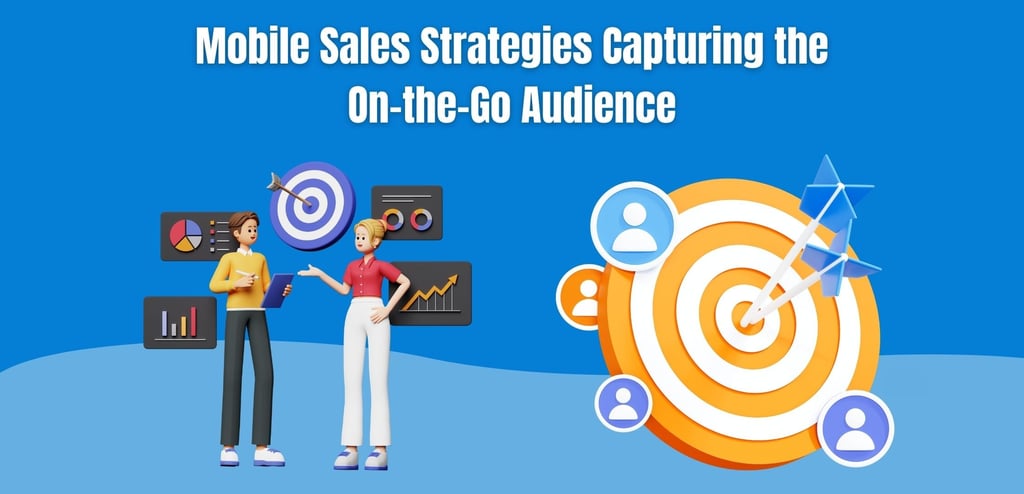
Mobile Sales Strategies Capturing the On-the-Go Audience
By AZ Konnect Team
11/28/20245 min read


In today’s fast-paced digital world, consumers are constantly on the move, and their mobile devices are their constant companions. Smartphones have become an integral part of our lives, from socializing and entertainment to shopping and decision-making. As mobile usage continues to grow, businesses must adapt their strategies to capture this ever-growing, on-the-go audience.
To stay competitive, companies need to create mobile sales strategies that not only engage users but also convert them into loyal customers. In this blog post, we'll explore key mobile sales strategies that can help you capture the attention of mobile users, improve their experience, and drive sales growth.
1. Mobile-Optimized Websites and Apps
At the heart of any successful mobile sales strategy is a mobile-optimized website or app. As more consumers use their smartphones to browse and shop online, having a responsive, mobile-friendly website is no longer optional—it’s essential.
Why It Matters:
User Experience:
If your site or app is difficult to navigate on a smartphone, potential customers will quickly lose interest and move on to a competitor. A smooth, intuitive experience on mobile devices helps keep users engaged and more likely to convert.
SEO Benefits:
Google prioritizes mobile-friendly websites in its search rankings. A well-optimized site will perform better in search engine results, making it easier for potential customers to find you.
Faster Load Times:
Mobile users have limited patience for slow-loading pages. A site that loads quickly will improve the overall user experience and reduce bounce rates, resulting in higher conversions.
Actionable Tips:
Responsive Design:
Ensure your website automatically adjusts to different screen sizes and resolutions for seamless viewing across all devices.
Simplify Navigation:
Use clear, concise menus and easy-to-find buttons to help users navigate your site with ease.
Reduce Load Times:
Compress images, minify code, and leverage content delivery networks (CDNs) to reduce page load times.
2. Leverage Mobile-First Marketing
The mobile audience behaves differently than desktop users, and your marketing efforts should reflect that. Mobile-first marketing focuses on creating content, ads, and campaigns that are specifically designed to engage users on their mobile devices.
Why It Matters:
Higher Engagement:
Mobile users are more likely to interact with content that is tailored for smaller screens and optimized for quick consumption.
Better Ad Performance:
Mobile-first ads that consider the way users interact with their devices, such as swiping and tapping, perform better than ads that are merely adapted from desktop formats.
Instant Access:
Mobile-first marketing allows users to engage with your content while they’re on the go, increasing the likelihood of immediate conversions.
Actionable Tips:
Use Mobile-Friendly Formats:
Short videos, Instagram Stories, and carousel ads work well for mobile. Focus on visual content that grabs attention quickly.
Leverage SMS Marketing:
Text messages have a high open rate, making SMS a powerful tool to engage customers with time-sensitive offers and updates.
Optimize for Voice Search:
With the rise of voice assistants like Siri and Google Assistant, ensure your content is optimized for voice search by incorporating conversational keywords and natural language.
3. Simplified Mobile Checkout Process
One of the biggest barriers to mobile sales is a complicated or time-consuming checkout process. A smooth, simplified checkout experience is essential for reducing cart abandonment and driving sales.
Why It Matters:
Higher Conversion Rates:
A streamlined, user-friendly checkout process can significantly increase conversions by making it easy for users to complete their purchases.
Lower Abandonment Rates:
Mobile users are more likely to abandon their carts if the checkout process is too complicated or requires too many steps. A frictionless experience leads to more completed purchases.
Trust and Security:
Mobile shoppers want to feel confident that their personal and payment information is secure. A simple, trustworthy checkout process helps build that confidence.
Actionable Tips:
Enable Guest Checkout:
Don’t force users to create an account to complete a purchase. Offer a guest checkout option for faster transactions.
Simplify Form Fields:
Limit the number of fields users need to fill out. Use autofill options to make the process quicker and easier.
Multiple Payment Options:
Integrate mobile-friendly payment solutions like Apple Pay, Google Pay, or PayPal to make transactions more convenient.
One-Click Checkout:
Consider implementing a one-click checkout option for returning customers to make the purchasing process as fast as possible.
4. Personalization and Localization
Mobile devices provide unique opportunities to deliver personalized and localized experiences. By leveraging user data and location-based technology, you can tailor your offerings and messages to meet the specific needs and preferences of your mobile audience.
Why It Matters:
Higher Engagement:
Personalized recommendations and offers based on a user’s browsing history or past purchases can increase engagement and drive repeat sales.
Increased Relevance:
Location-based marketing allows you to target customers with hyper-local offers, driving foot traffic to physical stores or promoting region-specific promotions.
Stronger Customer Relationships:
Personalized experiences foster a deeper connection between your brand and your customers, increasing loyalty and long-term value.
Actionable Tips:
Geotargeting:
Use geolocation data to send personalized offers to users based on their location. For example, a restaurant can send a discount to users who are nearby during lunch hours.
Personalized Recommendations:
Use data from past interactions to recommend products that a user is likely to be interested in.
Dynamic Content:
Tailor your website or app content based on the user’s preferences, previous behavior, or location.
5. Leverage Push Notifications
Push notifications are a powerful tool for re-engaging mobile users and driving sales. These short, attention-grabbing messages can prompt users to take action, such as completing a purchase, checking out a new product, or redeeming a special offer.
Why It Matters:
Higher Engagement Rates:
Push notifications are direct and appear on users' screens, making them more likely to be seen and acted upon compared to emails or social media posts.
Timely Engagement:
Push notifications allow you to send time-sensitive offers, reminders, or updates directly to users in real-time, increasing the likelihood of conversions.
Customer Retention:
Engaging users with relevant push notifications can encourage them to return to your app or website, boosting long-term customer retention.
Actionable Tips:
Offer Value:
Only send notifications that provide genuine value to the user, such as exclusive offers, product updates, or personalized recommendations.
Timing Matters:
Send push notifications at optimal times when users are most likely to engage, such as during commuting hours or lunch breaks.
Segment Your Audience:
Target different segments of your audience with personalized push notifications to make your messages more relevant and effective.
6. Mobile-Exclusive Deals and Offers
Mobile-exclusive deals are a great way to incentivize users to engage with your brand via their smartphones. Offering discounts, promotions, or loyalty rewards that are only accessible through mobile devices can drive mobile traffic and boost sales.
Why It Matters:
Increased Mobile Traffic:
Offering mobile-only discounts encourages users to shop on their devices, increasing mobile engagement and sales.
Customer Loyalty:
Exclusive offers make customers feel valued and can help build brand loyalty over time.
App Engagement:
Mobile-exclusive deals can incentivize users to download and use your app, increasing engagement and retention.
Actionable Tips:
Create Mobile-Only Coupons:
Offer special discounts or promotions that are only available through your mobile app or via SMS.
Reward Mobile Users:
Implement a mobile loyalty program where users can earn points or rewards for purchases made through your app or mobile site.
Time-Sensitive Offers:
Send push notifications or SMS messages with limited-time offers that encourage immediate action.
Conclusion
Capturing the on-the-go audience requires a well-thought-out mobile sales strategy that caters to the unique behaviors and preferences of mobile users. From mobile-optimized websites and apps to personalized marketing and simplified checkout processes, each element of your strategy should work together to create a seamless, engaging, and conversion-driven experience.
By implementing these strategies, businesses can stay competitive in the mobile-first world, meet customers where they are, and ultimately drive higher sales through mobile channels.
Subscribe To Our Newsletter


